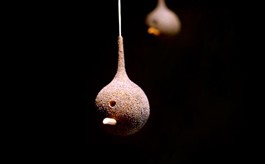BIRD FEEDER: Designer Nadine Jarvis creates a vessel of human ash and bird food
By Gretchen Giles
Sonoma County artist Rik Olson hadn’t seen his father for some 30 years when, he says, he “suddenly ended up with his ashes.” Estranged in life, Olson found himself in the unusual position of being his father’s most intimate guardian in death. So he did the next most logical thing. He set about building a Viking ship.
“We’re of Scandinavian heritage, and it seemed like an appropriate funeral vessel for a disposed old Viking family,” Olson explains by phone.
As boomers inexorably inch toward that final ship in the sky, death ceremonies have become more personalized, more eccentric and, assuredly, more green. Some 60 percent of Californians polled would prefer to be cremated, and estimates are that cremation throughout the United States will grow in popularity by 50 percent in the next 20 years. The reasons are various: distrust of the funeral industry; a desire to avoid high end-of-life cost; and a final wish to make the smallest footprint possible.
Olson bought a model wooden Viking ship and built it, enlarging the model’s plans by two and a half times so that the vessel was a yard long, sealing the under deck and modifying the upper deck.
“In the meantime,” he says drily, “my brother managed to pass away last February. The family seized on the idea that I’d had for my father, and got the idea of putting them together and launching them in the same place.” Replete with a proud carved prow and decorative shields adorned with the names of his father and brother, the boat was completed this summer.
Olson’s homespun vessel is just one reflection of what many artists around the world are doing, creating urns and memorial objects associated with death. An exhibit of some 80 fine art objects on the subject show Sept. 26–Nov. 30 at the Gallery at Funeria in Graton.
The only fine art gallery in the United States devoted to crematory objects, Funeria actively seeks out and encourages artists to embrace the subject. Among those who have really thought on the topic is English designer Nadine Jarvis. Reflecting life’s chaos, Jarvis crafts feeders made of human ash, seed and suet that are gradually devoured by wild birds. She puts human ashes in ceramic eggs that hang from a thread made to break—when and where being as unknown as death itself is guaranteed—smashing the vessel to the ground and scattering the ashes. Jarvis also creates pencils from human ashes—one person being roughly equivalent to 240 writing utensils—with a special sharpener that returns the ashes as shavings to the pencil box.
“It’s not only important for artists to be addressing this subject but I think that it’s incumbent upon them to come up with the creative opportunities,” says Funeria owner Maureen Lomasney. “Most people have no experience with [handling human remains]. They’ve only seen The Big Lebowski or heard horror stories.”
Gathering some 15 family members up near a former family Sierra cabin last July for the ceremony, Olson had deliberately built his family’s Viking ship out of balsa wood because, he explains, “I wanted it to break up over the rapids.” What rapids? “I can’t tell you,” he chuckles, “it’s against California state law.” Which is the rub. Many of us want to scatter a loved one’s ashes but don’t know where it’s an illegal act. “I’ve seen people doing it in Golden Gate Park,” Lomasney says, “and I don’t like to see that. Basically, it’s legal on most public lands, but it differs from state to state and county to county. And it’s always legal on private property.”
Undeterred, Olson mixed his father’s and brother’s ashes together in the under deck of the ship. Surprised by the weight, the ship rode lower than Olson had expected, but bravely launched off.
“It hit the rushing water and it swamped and swank and went down into very clear water and the ashes plumed out for 20 minutes or so,” he remembers. “We all stood and watched that and had our thoughts, and then we prodded the boat with a long stick and it re-emerged and went downstream. With its Viking figurehead, it looked like Nessie. It eventually broke up; I had built it to return to nature.”
Olson breaks his somber tone with a hearty laugh. “And you know,” he says of his late father and brother, “they’re probably the two most ill-equipped warriors ever to be in Valhalla.”
The Gallery at Funeria exhibits ‘Ashes to Art: Scattered’ Sept. 26-Nov. 30. A reception is slated for Friday, Sept. 26, from 6pm to 8pm; RSVP. A slide presentation of Rik Olson’s ad hoc Viking funeral will be shown. 2860 Bowen St., Graton. 707.829.1966.
Museums and gallery notes.
Reviews of new book releases.
Reviews and previews of new plays, operas and symphony performances.
Reviews and previews of new dance performances and events.











